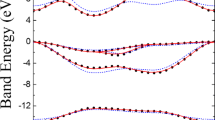Abstract
The electronic structure and bonding configuration of cubic (B1 type) Zr- and N-deficient zirconium nitride phases were investigated using self-consistent linearized muffin-tin-orbital calculations in the atomic-sphere approximation for a supercell containing eight atoms. Interatomic interactions were analyzed in terms of the crystalline orbital overlap population calculated by the semiempirical tight-binding method. The results are compared with earlier calculations and available experimental data on the electronic structure of nonstoichiometric ZrN.
Similar content being viewed by others
REFERENCES
Goldschmidt, H.J., Interstitial Alloys, London: Butterworths, 1967, vol. 1.
Toth, L.E., Transition Metal Carbides and Nitrides, New York: Academic, 1971.
Shveikin, G.P., Alyamovskii, S.I., Zainulin, Yu.G., et al., Soedineniya peremennogo sostava i ikh tverdye rastvory (Compounds of Variable Composition and Their Solid Solutions), Sverdlovsk: Ural. Nauchnyi Tsentr Akad. Nauk SSSR, 1984.
Gusev, A.I., Fizicheskaya khimiya nestekhiometricheskikh tugoplavkikh soedinenii (Physical Chemistry of Nonstoichiometric Refractory Compounds), Moscow: Nauka, 1991.
Rempel', A.A., Effekty uporyadocheniya v nestekhiometricheskikh soedineniyakh vnedreniya (Ordering Effects in Nonstoichiometric Interstitial Compounds), Yekaterinburg: Nauka, 1992.
Ivanovskii, A.L., Gubanov, V.A., Kurmaev, E.Z., and Shveikin, G.P., Electronic Structure and Chemical Bonding of Nonstoichiometric Refractory Group IV and V Transition-Metal Compounds, Usp. Khim., 1983, vol. 52, no. 3, pp. 705–732.
Marksteiner, P., Weinberger, P., Neckel, A., et al., Electronic Structure of Substoichiometric Carbides and Nitrides of Titanium and Vanadium, Phys. Rev. B: Condens. Matter, 1986, vol. 33, no. 2, pp. 812–820.
Ivanovskii, A.L., Anisimov, V.I., Novikov, D.L., et al., The Influence of Structural Defects on the Electronic Properties of Interstitial Alloys: I. Lattice Vacancies, J. Phys. Chem. Solids, 1989, vol. 49, no. 5, pp. 465–477.
Novikov, D.L., Ivanovskii, A.L., and Gubanov, V.A., The Influence of Carbon Vacancies on the Electronic Structure of Niobium Carbides, Phys. Status Solidi B, 1987, vol. 139, no. 3, pp. 257–265.
Ivanovskii, A.L., Anisimov, V.I., and Gubanov, V.A., Effects of Metal and Metalloid Vacancies on the Electronic Structure of Cubic (CaF2 and NaCl Types) Transition-Metal Phases, Metallofizika (Kiev), 1988, vol. 10, no. 2, pp. 47–54.
Ivanovskii, A.L., Zhukov, V.P., and Gubanov, V.A., Elektronnoe stroenie tugoplavkikh karbidov i nitridov perekhodnykh metallov (Electronic Structure of Refractory Transition-Metal Carbides and Nitrides), Moscow: Nauka, 1990.
Gubanov, V.A., Zhukov, V.P., and Ivanovskii, A.L., New Achievements in Theoretical Calculations of Electronic Structure and Properties of Transition Metal Compounds, Rev. Solid State Sci., 1991, vol. 5, no. 2/3, pp. 315–323.
Ivanovskii, A.L., Ternary Carbides and Nitrides of Transition Metals and Group IIIA and IVA Elements: Electronic Structure and Chemical Bonding, Usp. Khim., 1995, vol. 66, no. 6, pp. 499–518.
Ivanovskii, A.L. and Medvedeva, N.I., Electronic Structure of Metastable Cubic Ti-Al-Si-C-N-O Solid Solutions, Zh. Neorg. Khim., 1997, vol. 42, no. 5, pp. 789-799.
Schwarz, K., Williams, A., Cuomo, J., and Harper, J., Zirconium Nitride-A New Material for Josephson Junctions, Phys. Rev. B: Condens. Matter, 1985, vol. 32, no. 12, pp. 8312–8318.
Shalaeva, E.V., Borisov, S.V., and Makhnev, A.A., Structure and Optical Properties of Superstoichiometric Cubic Solution δ-NbN1, 2(C,O), Khimiya tverdogo tela: Struktura, svoistva i primenenie novykh neorganicheskikh materialov (Solid-State Chemistry: Structure, Properties, and Applications of New Inorganic Materials), Shveikin, G.P. and Ivanovskii, A.L., Eds., Yekaterinburg: Inst. Khimii Tverdogo Tela Ural. Otd. Ross. Akad. Nauk, 1998, pp. 56–65.
Marksteiner, P., Weinberger, P., Neckel, A., et al., On the Electronic Structure of Zirconium Nitride: The Influence of Metal Vacancies, J. Phys. F: Metal Phys., 1986, vol. 16, no. 9, pp. 1495–1500.
Ivashchenko, V.I., Trofimova, E.P., Lisenko, A.A., and Zhurakovskii, E.A., Electronic Structure of Zirconium Nitrides Containing Zirconium and Nitrogen Vacancies, Metallofizika (Kiev), 1990, vol. 11, no. 1, pp. 14–21.
Prieto, P., Galan, L., and Sanz, J.M., Electronic Structure of Insulating Zirconium Nitride, Phys. Rev. B: Condens. Matter, 1993, vol. 47, no. 3, pp. 1613–1615.
Prieto, P., Fernandez, A., Soriano, L., et al., Electronic Structure of Insulating Zr3N4 Studied by Resonant Photoemission, Phys. Rev. B: Condens. Matter, 1995, vol. 51, no. 24, pp. 17984–17987.
Prieto, P., Yubero, F., Elizalde, E., and Sanz, J.M., Dielectric Properties of Zr, ZrN, Zr3N4, and ZrO2 Determined by Quantitative Analysis of Energy Loss Spectra, J. Vac. Sci. Technol., A, 1996, vol. 14, no. 6, pp. 3181-31188.
Lerch, M., Fuglein, E., and Wrba, J., Synthesis, Crystal Structure, and High Temperature Behavior of Zr3N4, Z. Anorg. Allg. Chem., 1996, vol. 622, no. 2, pp. 367–372.
Skriver, H., The LMTO Method, Berlin: Springer, 1984.
Hoffmann, R., Solids and Surfaces: A Chemist's View of Bonding in Extended Structures, New York: VCH, 1985, pp. 26–32.
Rempel', A.A., Ordering of Atoms and Vacancies in Nonstoichiometric Carbides, Usp. Fiz. Nauk, 1996, vol. 166, no. 1, pp. 33–62.
Gusev, A.A., Order-Disorder Transitions and Phase Equilibria in Highly Nonstoichiometric Carbides, Usp. Fiz. Nauk, 2000, vol. 170, no. 1, pp. 3–40.
Marksteiner, P., Weinberger, P., Neckel, A., et al., Electronic Structure of Substoichiometric Carbides and Nitrides of Zirconium and Niobium, Phys. Rev. B: Condens. Matter, 1986, vol. 33, no. 10, pp. 6709–6717.
Ivanovskii, A.L. and Elfimov, I.S., Effect of Carbon Vacancies on the Electronic Structure of VzTiyCx Carbides: Ab initio LMTO Calculations, Fiz. Tverd. Tela (S.-Peterburg), 1996, vol. 38, no. 12, pp. 3608–3613.
Ivanovskii, A.L., Kontsevoi, O.Yu., Bamburov, V.G., and Shveikin, G.P., Synthesis and Electronic Structure of Cubic Solid Solutions in the Systems Sc2CO-ZrN and Sc2CO-HfN, Dokl. Akad. Nauk, 1998, vol. 363, no. 1, pp. 68–70.
Author information
Authors and Affiliations
Rights and permissions
About this article
Cite this article
Ivanovskii, A.L., Medvedeva, N.I. & Okatov, S.V. Effect of Vacancies on the Electronic Structure and Bonding of Zirconium Nitride. Inorganic Materials 37, 459–465 (2001). https://doi.org/10.1023/A:1017568515295
Issue Date:
DOI: https://doi.org/10.1023/A:1017568515295



